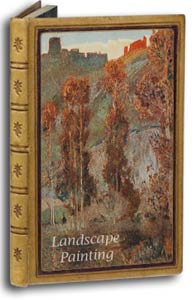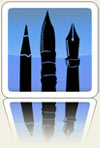Landscape Painting
 Released today is an unabridged art book on landscape painting by Alfred East. The book starts by acknowledging that technical proficiency does not necessarily go hand-in-hand with producing beautiful works of art. The second chapter, painting nature, is all about the artists’ attitude towards nature, and being able to paint with authority. It is recommended that paintings are built from broad masses, working all areas at the same time, like a musical conductor keeping the orchestra in check. It is recommended that you take to studying daily – if you draw and paint a tree or sky every day, after several months your understanding will increase significantly.
Released today is an unabridged art book on landscape painting by Alfred East. The book starts by acknowledging that technical proficiency does not necessarily go hand-in-hand with producing beautiful works of art. The second chapter, painting nature, is all about the artists’ attitude towards nature, and being able to paint with authority. It is recommended that paintings are built from broad masses, working all areas at the same time, like a musical conductor keeping the orchestra in check. It is recommended that you take to studying daily – if you draw and paint a tree or sky every day, after several months your understanding will increase significantly.
Painting materials covers not only what essential art tools to bring along with you, but also the practicalities of seating, and facing the elements.
Sketching from nature involves being out in the field, and warns on the dangers of painting the middle-ground in landscapes. There is the risk that the same colours as the foreground are used merely with an addition of white, whereby what the artist actually requires is not only change of pigment, but a fresh combination of colour.
Pencil Drawing from nature is about using a sketchbook and pencil to capture your scenes, and should be done so on a daily basis. Scales and exercises are to the pianist as pencil drawings are to the artist.
Art Composition is all about the arrangement of forms upon your canvas. Although it is easy to see examples of bad composition, creating good compositions is not an easy task. Beware of creating equal quantities of light and dark, and take note of repetitions in nature that may lead to your landscape painting being left somewhat bland.
What is colour? asks the philosophical and scientific question that is hard to define precisely. We call yellow, yellow, yet there are thousands of variations of yellow out there with no conventional names.
Painting trees covers the essential topic that no landscape painter can forego. It is only by drawing many different types of trees on a regular basis, that the artist can begin to appreciate and understand them. The correct lighting and modelling of trees involves seeing their rounded nature, so as to avoid flat tones, and the use of edges against the sky.
From trees to painting the sky – If you have the motivation and discipline to paint a sky every morning, within six months you will understand more about its variations. Half an hour a day is all that is required, and to spend longer will lead to frustration as skies are dynamic and change constantly. This chapter also covers a sky palette to achieve blues that are not too dominate or overpowering.
Painting grass acknowledges that painting every blade would be tiresome and stupid. Grass is composed of many shades of green and can appear differently due to reflection, and perspective, depending how close or far away it may be. Weeds and other plants also add to the variations in green. It is important to paint grass as a mass; the author provides a suitable palette for doing so.
Painting reflections covers not only reflections in water, but other elements such as the roofs of houses, that may bounce light in such a manner as to become the most brilliant area in a painting. Grass reflects, and may change the shadows of a cow, or change the colours of a tree trunk.
Distance in painting examines landscape painting from afar. The light in Britain differs greatly from that in Italy, and such atmospheric changes should be represented in your art, and within your palette.
The last chapters cover what to paint and plein air painting, championing the cause of painting directly from nature.

Reader Comments
The wording is a little ‘macho’ but I guess that reflects the times it was written in. A wonderful book though, with some great tips on landscapes in oil (one of my favourite subjects!).